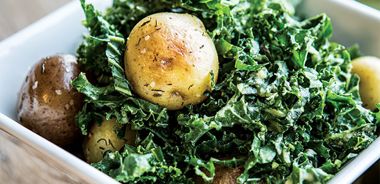Kale Slaw with Chickpea Caesar Dressing and New Potato Croutons

The secret to creamy Caesar dressing without mayonnaise is in the unassuming chickpea. Along with adding body, chickpeas deliver protein, fibre, and iron. This dressing can be prepared up to one week in advance.
Crispy croutons made with new potatoes deliver that stock Caesar crunch. Whenever possible, choose organic ingredients.
Croutons
1/2 lb (225 g) new potatoes 2 Tbsp (30 mL) butter or coconut oil 1/2 tsp (2 mL) dried dill 1/4 tsp (1 mL) sea salt
Dressing
1 cup (250 mL) cooked chickpeas, drained and rinsed if using canned 1 to 2 garlic cloves, minced 1/4 cup (60 mL) lemon juice 1/4 cup (60 mL) grated Parmesan cheese or nutritional yeast (for dairy-free) 1/3 cup (80 mL) extra-virgin olive oil 1/4 tsp (1 mL) sea salt 1/2 tsp (2 mL) ground black pepper 1/2 cup (125 mL) water, to thin (you may not use full amount)
Slaw
1 bunch kale, de-stemmed and sliced into thin ribbons
Preheat oven to 300 F (150 C).
Fill medium pot halfway with water and bring to boil. Place potatoes in steamer basket over boiling water. Steam until slightly tender but not fully cooked (do not overcook or they’ll crumble). Allow to cool slightly.
Warm oil or butter in large skillet over medium heat. Add steamed potatoes and sprinkle dill and salt evenly over potatoes. Sauté for 5 to 10 minutes, until potatoes are starting to brown and crisp. Transfer to large baking sheet and keep warm in oven while preparing slaw.
Place all dressing ingredients except water in blender or food processor. Purée until creamy. Slowly add water until dressing is thin enough to toss with kale (depends on whether you prefer a thicker or thinner Caesar dressing).
In large bowl, toss shredded kale with enough dressing to coat (it’s possible you won’t use all dressing). Refrigerate for 5 to 10 minutes. Divide salad among serving bowls and top with potato croutons. Serve immediately.
Dressed slaw can be refrigerated for up to 3 days. Keep potato croutons in separate container, reheating in oven and topping slaw just before serving.
Serves 6.
Each serving contains: 285 calories; 7 g protein; 19 g total fat (7 g sat. fat, 0 g trans fat); 24 g total carbohydrates (2 g sugars, 4 g fibre); 296 mg sodium
source: "Spring Slaws", alive #390, April 2015





